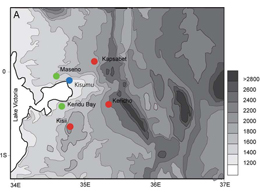Research Abstract
インド洋ダイポール現象が東アフリカ高地においてマラリアの再流行をもたらす
Indian Ocean Dipole drives malaria resurgence in East African highlands
2012年2月16日 Scientific Reports 2 : 269 doi: 10.1038/srep00269

1990年代に東アフリカ高地においてマラリア流行が再発した。これまで、エルニーニョ・南方振動(ENSO)の影響も含めて、原因に関する議論が続いていた。しかし、ENSOよりも、他の異常気象が高地におけるマラリア再流行により関係しているとも考えられた。本研究では、インド洋ダイポール現象(IOD)と呼ばれるインド洋における大気海洋相互作用現象がマラリア流行に影響を与えたことを示した。クロスウェーブレット相関解析を用いた結果、3か所の高地における1990年代のマラリア患者数の時系列とダイポールモードインテックス(DMI)の間には、4年周期の相関が存在することを認めた。逆に、低地においては、マラリア患者数とDMIの間には顕著な相関は見られなかった。この高地と低地の間の違いは、ビクトリア湖から発生するメソスケール気象擾乱の効果により説明できる。よって、この研究結果は、東アフリカ高地におけるマラリア再流行の原因として、IODを考慮する必要性を示している。
- 長崎大学 熱帯医学研究所
- 北海道大学大学院 環境科学研究院
Malaria resurgence in African highlands in the 1990s has raised questions about the underlying drivers of the increase in disease incidence including the role of El-Niño-Southern Oscillation (ENSO). However, climatic anomalies other than the ENSO are clearly associated with malaria outbreaks in the highlands. Here we show that the Indian Ocean Dipole (IOD), a coupled ocean-atmosphere interaction in the Indian Ocean, affected highland malaria re-emergence. Using cross-wavelet coherence analysis, we found four-year long coherent cycles between the malaria time series and the dipole mode index (DMI) in the 1990s in three highland localities. Conversely, we found a less pronounced coherence between malaria and DMI in lowland localities. The highland/lowland contrast can be explained by the effects of mesoscale systems generated by Lake Victoria on its climate basin. Our results support the need to consider IOD as a driving force in the resurgence of malaria in the East African highlands.

